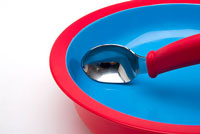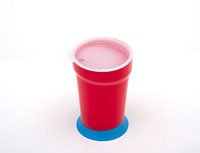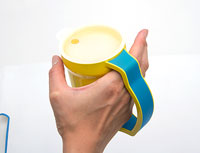In older adults, physiologic changes can lead to malnutrition and dehydration. This includes changes to the gastrointestinal system, reduced function of salivary glands, and reduction of taste and smell. Difficulty swallowing, decreased appetite, and changes in eating habits also occur as dementia progresses.
Malnutrition is an inadequate diet in which either the quantity or quality of nutrients does not meet nutritional needs. It includes both over-nutrition and undernutrition. Undernutrition affects up to 10% of older people living at home, 30% of those living in care homes, and 70% of hospitalized older adults. Malnutrition in older adults with dementia (ADI, 2014):
- Increases frailty, skin fragility, falls, hospitalization, and mortality.
- Tends to be progressive, with weight loss often preceding the onset of dementia and increasing as the disease progresses.
Dehydration occurs when fluid loss is greater than fluid intake or when there is an excessive loss of body fluid. It is one of the ten most frequent diagnoses related to the hospitalization of older adults in the United States. Nutrition studies demonstrate that a loss of only 1% to 2% of total body water may result in impaired cognitive performance; in older adults this percentage was shown to be even lower (Sfera et al., 2016).
Despite these serious issues, nutrition is an almost totally neglected area of study in people with dementia. Studies indicate that 20% to 45% of people with dementia living in the community experience clinically significant weight loss over one year, and that up to half of people with dementia in care homes do not get enough food (ADI, 2014).
11.1 Risk Factors for Malnutrition and Dehydration
Swallowing disorders and lack of oral care are 2 of the most common risk factors for malnutrition and dehydration in older adults. For a person with sensory changes related to dementia, eating takes time. The lack of individualized help from properly trained staff, unappetizing food (or food served cold), staff or caregiver neglect, and food and drug interactions are very common. Something that takes a few minutes for a younger person, may take a half hour or more for a person with dementia.
Illness, depression, and loneliness also affect a person’s desire to eat—especially if housebound with little or no help. Someone with dementia and limited mobility may not feel hungry at appointed mealtimes, may be unable to open a package containing utensils, or may not remember to eat, leading to skipped meals. Cultural and language differences also affect a person’s desire to eat and drink. This is especially true if food preferences are not considered.
11.2 Signs and Symptoms of Malnutrition and Dehydration
Signs and symptoms of malnutrition include weight loss and decreased muscle mass, lightheadedness and dizziness, and an inability to keep warm. A sore mouth or swollen and bleeding gums affects chewing and swallowing. Malnutrition can cause constipation (or diarrhea), recurrent infections, fatigue and weakness, and a bloated abdomen.
Signs and symptoms of dehydration include thirst, dry skin, fatigue, and sluggishness. Other symptoms can include dizziness, confusion, and nausea.
As dementia progresses—especially a person approaches the severe stage, they may refuse food and drink. This can be especially stressful and concerning for caregivers. Hand feeding can be stigmatizing, and some people may resist being helped in this way. Many people experience difficulties with swallowing, choking, and aspiration. It is not uncommon for someone to chew food and hold it in their mouth, failing to swallow.
Aversive, resistive behaviors can be related to (ADI, 2014):
- Inability to use utensils or distinguish food from non-food (dyspraxia/agnosia).
- Turning the head away, blocking mouth with hands, biting caregiver, spitting or throwing food (resistance).
- Difficulty opening mouth, continuous tongue or mouth movements, chewing without swallowing (oral neuromuscular incoordination).
- Only willing to eat certain food or fluids (food preferences).
11.3 Strategies for Addressing Malnutrition and Dehydration
I was very frustrated that I wasn’t able to find a microwave with controls my dad could see. The industrial look—gray numbers on a black background, plus a bunch of unnecessary functions made it nearly impossible for him to heat his coffee in the morning or heat up what we prepared him for lunch. Now, as I am aging, I realize that I also have trouble seeing the buttons on my microwave. There are a lot of people who don’t have perfect vision—I hate that nobody seems to take this into account during the design.
Soana, Occupational Therapist, Miami
Encouraging proper nutrition and hydration, promoting independence in eating, and ensuring that eating is a pleasurable activity is an important part of a person’s overall care. With good planning and proper training, malnutrition and dehydration can generally be prevented or reduced.
Clients with dementia take longer to eat, require prompting and encouragement, and may have problems with coordination and swallowing. Training, education, and support are needed for caregivers, particularly when aversive feeding behaviors and feeding difficulties occur. Basic information should be provided to families and training and dietician services should be available (ADI, 2014).
Promoting independent, pleasurable eating and drinking should focus on three levels (Palese et al., 2018):
- Environmental: ritualizing the mealtime experience by creating a controlled stimulated environment.
- Social: structuring effective mealtime social interactions.
- Individual: individualizing eating assistance.
Despite the seriousness of malnutrition and dehydration in people with dementia, Jane Murphy and Joanne Holmes at the Burdett Trust for Nursing (Nutridignity in Dementia) point out that (Murphy and Holmes, 2015):
- There are no standardized interventions that address the maintenance of adequate nutrition.
- There is a lack of nutrition training, skills, and leadership to embed values and behaviors in care.
- There is poor recognition of the “meal experience” within the context of person-centered care.
Professor Jane Murphy talks about nutrition in dementia care [2:23]
https://youtu.be/4z6lJx9LSDc
Source: Bournemouth University
https://www.bournemouth.ac.uk/research/projects/optimising-food-nutritional-care-people-dementia
11.3.1 Assistive Tableware
Assistive or adaptive tableware is an important tool for people experiencing difficulties with eating and drinking. Unfortunately, it is not used as much as it could be, and users of assistive table settings often feel different and stigmatized.
The physical environment plays an important role in managing the challenges that patients with dementia experience with everyday activities. There is evidence that the use of high-contrast tableware increases liquid and food intake in patients with advanced dementia (Ocal et al., 2023). A variety of colors have been studied to find alternatives to standard, white tableware.
Well-designed assistive tableware should offer a range of matching items that form a complete set, can be used by people of all abilities, and resemble standard tableware. Color contrasts should feature prominently—for example royal blue plates provide a contrast both with a white table covering and food on a plate.


The slanted bottom hip lip of the plate can help users to gather food on one side without scooping. Spoon heads are designed to match the curvature of the bowls to pick up the food more easily. Designed by Sha Yao, Eatwell.com. Used with permission.
The same approach can be used with cups; for example, royal blue and white can be used to help those with low visual acuity or agnosia locate the handle and rim. The sides of the cup should be angled to reduce the need to tip the cup, a large handle will assure a good grip, and the top should be wide enough to allow a person’s nose to fit inside the cup when tipped (ADI, 2014).


A cup with a weighted bottom is shown on the left. A cup with an easy-to-grip handle is shown on the right. Designed by Sha Yao, Eatwell.com. Used with permission.

An example of a complete set of assistive tableware. This tableware design applied research from Boston University. According to the study, colors help a person with dementia to reduce visual impairment and consume 24% more food and 84% more liquid. Designed by Sha Yao, Eatwell.com. Used with permission.
The standard “care cup” is one of the most disliked assistive tableware items because it looks like a baby product. Its purpose is to help clients with reduced strength and dexterity grip both sides of the cup without spilling the liquid or burning their hands, as they might with a ceramic mug. An alternative approach is using a ceramic cup with a double skin and an air-filled cavity between the inside and outside surfaces. This keeps liquids warm while the outside of the cup remains cool (ADI, 2014).
11.3.2 Red Plate Study
A 2004 study by Tracy Dunne found that using high-contrast red tableware instead during meals for patients with advanced dementia increased food intake by 25%. Liquid intake increased by more than 80% (Dunne et al., 2004).
11.3.3 Modifications to Mealtime Environment and Routine
The last 30 years have seen a gradual transition to flexible, individualized, and person-centered care that more closely resembles a household. For people with dementia, it may be particularly important to have a dedicated dining room, the use of which is limited to meals and food. This should look like a dining room in a home, with recognizable furniture such as dining tables and sideboards (ADI, 2014).
Large communal dining areas should be avoided, especially for clients with dementia. Large dining spaces can be noisy and confusing, with too much sensory distraction, which do not provide the sensory cues that orient a person with dementia to mealtime. Smaller dining rooms have a more intimate and familiar ambience and reduce confusion about the function of the room. Smaller dining rooms, bright and welcoming colors, and other residential features seem to be associated with increased food intake (ADI, 2014).
“Eat-in-kitchens” linked to dining areas help involve clients in meal preparation. Kitchens evoke feelings of warmth, comfort, and security. Linking the eating area to a kitchen stimulates all the senses with the smell and sound of cooking, cueing that a meal is about to take place. Food preparation smells stimulate the appetite of people with dementia and remind them of mealtimes (ADI, 2014).
11.4 Dietary Restrictions and Challenges
In older adults with dementia, dietary restrictions and challenges associated with changes in eating behavior can cause significant issues for caregivers. As food becomes less palatable and senses decline, these changes affect the taste, smell, and texture of food. Swallowing difficulties can lead to coughing and aspiration, turning eating into an unpleasant chore.
For people on restricted diets due to high blood pressure or diabetes, salt and sugar may be restricted, making food bland and tasteless. For people with swallowing difficulties or those at risk for aspiration, thickened liquids and chopped-up food may be unfamiliar and unsatisfying. People living in areas without easy access to a good grocery store, people with mobility issues, or those unable to afford good quality food may not be able to meet nutritional needs.
11.5 Addressing Concerns about Malnutrition, Undernutrition, and Dehydration
It is sometimes difficult for caregivers and family members to recognize that as we age, food preferences change, activity levels decline, and meals become less social. For a person experiencing the cognitive and sensory changes associated with dementia, these changes are magnified.
Researchers at the Ageing and Dementia Resources Centre at Bournemouth University have developed 6 person-centered care recommendations designed to address these concerns, while supporting staff, caregivers, and people with dementia (ADRC, 2018):
- Offer a variety of different, nutritional foods and drinks, available throughout the day, that account for cultural, religious, and food preferences of each individual.
- Monitor and screen regularly for dehydration and undernutrition.
- Encourage meals with family members, care staff, and other residents.
- Encourage participation in meaningful activities, meal planning, and food preparation.
- Keep care consistent.
- Provide accurate and trusted information about nutrition.
In adult day care centers, clients are required to be offered refreshments throughout the day. The refreshment, as well as meals, must adhere to the USDA dietary guidelines. Lunch and snacks must come from USDA food groups and be supplied by an approved vendor. Adequate hydration must be provided (at least 3x/day) and beverages must be provided outdoors and in hot areas where dehydration may be an issue.
Oral protein and energy supplements can be used in older people with undernutrition, or at risk of undernutrition. Their use is associated with significant weight gain, and a reduction in mortality for those who are undernourished (ADI, 2014). Fruits and vegetables are important sources of micronutrients, including vitamins E and C. Fiber, vitamins, and micronutrients and bioactive compounds are often below recommended dietary allowances.
